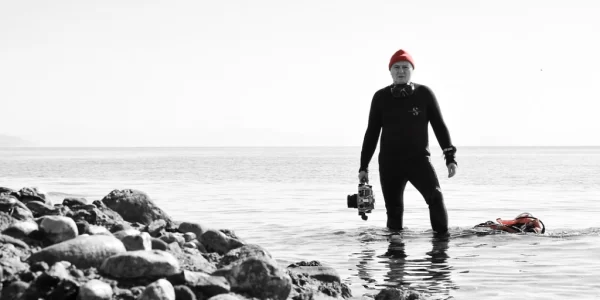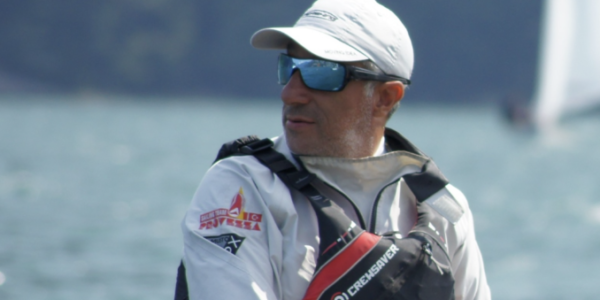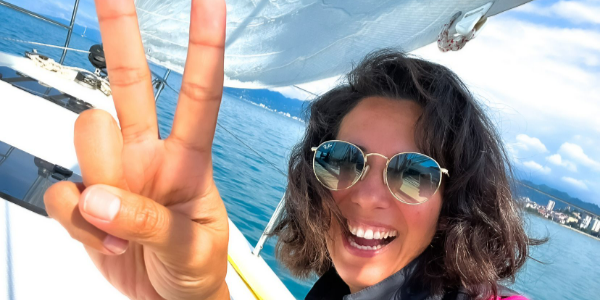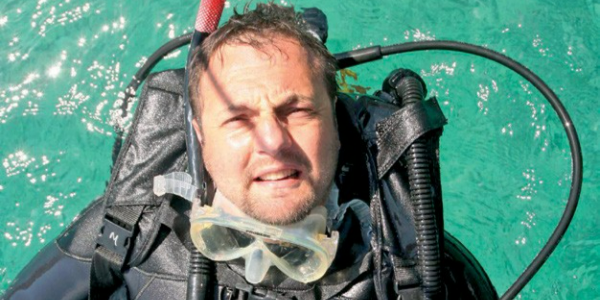On a liveaboard trip in northern Indonesia, a colleague made a dive at a current-prone site known for big marine life.
“During the briefing, the cruise director told us the site had medium current,” recalls Becca Hurley, online editor for Sport Diver and Scuba Diving. “But after descending, I realized it was the strongest current I’d ever been in.”
The group followed the dive guide, hooking into the reef at the edge of a channel at about 85 feet. Hanging in the channel was a huge school of barracuda.
“As soon as we unhooked, we got into difficulty,” Hurley says. “One of the underwater photographers was swept up and away from us. My buddy and I were fighting to ascend on the reef’s slope by grabbing dead rock and pulling ourselves up.”
They managed to get shallower, but the pair was running low on air. After a few moments of little progress, unable to overcome the current’s flow, Hurley’s buddy signaled to let go.
“When we surfaced, we were only a few yards from the photographer. We immediately inflated our safety sausages and the dinghy crew spotted us and picked us up,” says Hurley. “But what kept running through my mind as we ascended, with the force of the current pushing us, was that we were being swept out to sea.”
There were three groups of divers in the water that day; each group had a guide. The divers all hooked into the reef, but Hurley’s group was right at the edge of the reef, at the channel cut where the current was strongest. Hurley says the mistake her group made was in trying to cross the channel as they began their ascent. As they struggled to reach the reef, she and her buddy were separated from their dive guide and the rest of the group.
When it’s calm, the ocean is a place of refuge for just about anyone who loves being on the water — swimmers, stand-up paddle boarders, kayakers, boaters, and of course, divers. But eventually, every ocean diver will face a stiffer-than-expected current, an extreme tidal shift, an up or down current, or a tumultuous vortex or “washing machine” drift dive. Here are our best tips for dealing with these.
Heavy Current
Current can be found on the surface, in mid-water or at the bottom. Assuming you’re not doing a planned live-boat drift dive — with your exit down-current from your starting point — follow these strategies for beginning and ending in the same place.
• Pay attention to the briefing. If there’s surface current, the boat crew will have specific instructions for getting into the water, including hanging on to a tag line so that you can descend together as a group. These lines trail off the stern of the boat. Losing contact with the line, even momentarily, could result in you being swept away. In very heavy current, and if you’re descending down a mooring line, they’ll most likely also use a granny line. These lines either run alongside the boat and are tied off to the mooring or anchor line, or are tied off to the tag line and lead to the site.
• Be aware of your surroundings. At depth, you can tell which way the current is running by observing the marine life. Soft corals are pushed in the direction the current is moving, and schools of fish face into the current. Start the dive by swimming into the current so that once you turn the dive, you’ve got an easier swim back to your starting point.
• Drop down. If the current picks up, changes direction or pops up unexpectedly during a dive, you can descend a bit, to where the effect of the flow is hopefully not as strong. Generally, current is strongest at the surface or in midwater.
• Stay together as a group. If others in your group are lagging behind, look for a coral outcropping or some sort of shelter so that stragglers can catch up.
“You want to make sure all the divers can make it back to the boat safely,” says Liz Parkinson, an instructor with Stuart Cove’s Dive Bahamas. “Air consumption can be a problem.” That’s because as you kick more vigorously to make progress, you also breathe harder.
• Call the dive, if necessary. If the current isn’t manageable, abort the dive. If you’re in a group, don’t be surprised if the dive leader calls the dive. “The dive guide has to make the call as to whether the dive site is safe enough, and if it falls within the certification, ability and comfort level of her divers,” says Parkinson. And by all means, if you’re struggling but the dive guide is continuing the dive, let him and your buddy know. Electing to skip a challenging dive is not the worst thing that can happen to you.
• Follow instructions to exit the water. Your briefing will also include how to get back on the boat. In heavy current, you’ll use the anchor or mooring line to make your safety stop and use a granny line to get back to the boat’s ladder. If divers are beginning to bunch up at the ladder, grab onto the tagline and wait until it is your turn to exit.
Vertical Currents
Currents that are strong enough to push you up or down can be unnerving — and can be dangerous. An up current or upwelling is a current that comes from deeper water and propels everything in its path toward the surface. Conversely, a down current or downwelling typically starts in shallow water, rushes over the lip of a wall and flows down along the wall’s face. These can also occur when two currents collide from opposite directions. You can be forced shallower or deeper within seconds.
“I was leading a group of eight people on a wall dive,” recalls Parkinson. “We had beautiful conditions, no surface current, clear blue water. We got down to the edge of the wall at 40 feet, and I noticed that larger schools of fish were swimming up onto the reef and hiding behind huge rock structures. It did not take me long to realize that a down-current had picked up and we were being pushed out and over the edge.
“Luckily, I didn’t have a large group, and they were all experienced. I hugged the wall as closely as I could and led them to a different part of the reef until we no longer felt the pull. It is a scary feeling being pushed down into deep water, but I was grateful that everyone knew what to do.”
If you find yourself in a situation like Parkinson’s, follow these tips.
Down-current
• Reverse your direction and swim parallel to the wall. Often, if you realize it quickly, you can avoid a more dangerous situation. Down-currents are like waterfalls, so moving even just a few feet to either side can greatly change the strength of the current.
• Add air to your BC and dump your weights, if necessary. You might need to inflate it completely. If that doesn’t work, try to reach the wall and pull yourself up. If the current is too strong, try to pull yourself horizontally. Once you are able to get out of the down-welling, re-establish your buoyancy and dump the air out of your BC as you begin your ascent.
• Ride it out. If the above fails, stay calm. A down-current diminishes in strength as it goes deeper. Once it weakens, move either left or right to get out of it, and then ascend. As you make your ascent, check your dive computer and make all required safety stops.
Up-current
• Reverse your direction, and swim parallel to the wall. Just as with a down-current, it’s possible to escape the clutches of an upwelling if you realize it before you enter it fully.
• Empty your BC bladder of air. This will help slow your ascent and help prevent a decompression injury. If you do find yourself on an express elevator to the surface, flare out your arms and legs to slow the ascent. Continue to deflate your BC, and don’t forget to exhale.
• Deploy surface signaling devices. Once the boat crew spots you, stay calm. They might need to pick up other divers before reaching you.
Tidal Currents
Tidal currents travel from the open ocean toward the shore on a rising tide or from the shoreline to the open ocean on a falling tide. Here’s how to handle them.
• Read the local tide tables. Consult a tide chart and make a dive plan that’s based on when to enter and exit the water. If you’re not experienced with tidal currents or the local sites, dive with a local guide.
“You can try doing it yourself and googling it, but local knowledge is always a great source of information,” advises Parkinson. An experienced local dive operator can tell you a great deal more than when high and low tide is. They can let you know the easiest entry and exit points, where to find marine life, and the best place to grab a post-dive beer.
Always dive during a slack tide — slack high tide and low tide occurs when the tide reaches its highest and lowest point, respectively. During these periods, you’ll experience less current.
• Carry the proper gear. “It’s important to dive with a timing device, SMB and audible signal device,” says Parkinson. “Plan for a couple of exit points, in case you mistime your bottom time.”
• Tell someone your dive plan. Make sure someone knows your precise dive plan. Better yet, have someone waiting for you on shore. That way, if you get swept away and miss your planned exit time, a search team can begin looking for you as soon as possible.
Washing-Machine and Vortex Currents
There are sites around the world named Washing Machine and Vortex, and when the dive is planned, these roller-coaster-type rides can be a lot of fun. A washing-machine current occurs when the bottom typography bounces currents around. The telltale sign of a vortex current is a snake of bubbles. These types of currents can toss you like a beach ball on a windy day, making you extremely disoriented. Luckily, both of these currents are rare, and if you possess situational awareness, you’ll notice the water “behaving” erratically and can take steps to avoid being caught in one.
• Swim out horizontally. As with up- and down-currents, try to kick out of the current horizontally — the current will be weaker on the edges.
• Hang on to your gear. The force of these currents can dislodge gear, especially regulators and masks.
• Go with the flow. It will dissipate; once you’re out of the current’s grip, establish buoyancy and end the dive safely.
Gear Considerations
These recommendations are useful any time you dive, but are imperative when you dive in current.
• Streamline. Dangling items can create drag — plus, that expensive gauge or octo can be damaged.
• Don’t be overweighted. Although extra weight can help you descend quickly when you’re making a negative ascent in current, it can work against you when you’re having to fin against it.
• Carry multiple signaling devices. You can tuck a safety sausage, mirror and whistle in a BC pocket, or attach to a D-ring. If you dive regularly where currents are present, you might want to consider purchasing a Nautilus GPS. When activated, the GPS emits a GPS-specific distress signal to boats within an 8-mile radius.
Stop, Think, Act
If you’re caught in a powerful current, remember the training mantra “Stop, think, act.” You’re in a self-rescue situation, and you’ll need to make decisions and take steps to end the dive safely.
Source: sport diver





























































































































































